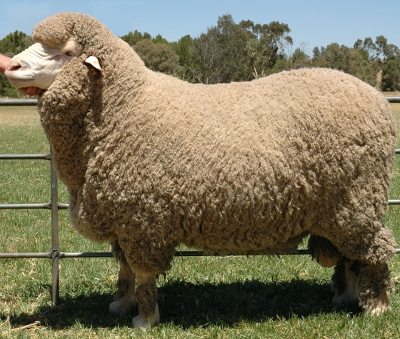Merino Sheep
Category: Sheep

Facts about Merino Sheep, "Scientific name for Merino Sheep is Ovis aries". Merino sheep are raised mainly for the wool that it produces. The wrinkled type of Merino Sheep were preferred in the early days as they were capable of producing much amount of wool but the issues like wool blindness and fly strike has led to the preference getting changed to plain Merion.
size of Merino Sheep
The Merino Sheep Ewes should weigh from 100 to 120 pounds (54.4 kg) and produce a fleece or 14 to 18 pounds (6.4 to 8.2 kg). The sheep rams average weight is from 160 to 180 pounds (72.6 to 81.6 kg) at maturity and produce fleece of upwards of 25 pounds (11.3 kg).
The Merino Sheep that are wrinkled heavily were also very slow in shearing. The race is in the breed sheep that need no mulesing. Mulesing is the process that require a single strip of skin to get removed from either side of the tail for attaining a surface that is smooth so that the possibility of having fly strike can be reduced. This practice is banned by most of the countries as this is the process that is carried out without using anesthesia and many of the groups of animal rights have raised their voice against it. Nearly 80 percentage of the sheep in Australia are pure Merino Sheep and are good in producing heaving fleece as well as excellent wool.
The Merino Sheep have got the general appearance as well as name from Spanish Merino and are capable of suiting the conditions of Australia. The Merino Sheep breeds are crossed with sires under less severe conditions for producing fat lambs.
The wool that is taken from Merino Sheep has greater popularity due to it’s excellent quality and is usually categorized into four major types that include strong, medium and fine. Each different kind of wool can be suitable for different climatic conditions. The fine and ultra-fine medium grades also have their different uses. Grading of the wool is done by measuring diameter of fiber in it. The length of the wool can be different according to the kind of wool. Ultra-fine wool is available with lesser than 17.5 microns. The fiber that is available between 17.6 – 18.5 microns are available to 70 mm. The fine wool has got 19.5 microns with staple length that ranges to about 75 mm.
The color of the superfine wool of Merino Sheep is excellent and is also denser as well as soft. Fine wool is available in good density and better brightness. Medium wool from Merino Sheep is considered in the textile industry. There are various kinds of Merinos evolved over time that can be suitable for the various climatic conditions of Australia. Merino wool is popular in high-end, overall performance athletic wear. Usually meant for utilize in hiking, running, mountain climbing, cycling, skiing, and also in other types of outdoor aerobic exercise, these kind of clothes control a premium over synthetic fabrics .
Some Merino Sheep Facts
Merino Sheep have a 300 degrees field of vision and sheep do not have to turn their head to see behind them and they have excellent hearing. Sheep have long been used to control unwanted vegetation. Shelter is not necessary in the rain but they do seek shade from the sun. There are over 900 different sheep breeds in the world and 40 different breeds of sheep in the United States. A Merino Sheep does not have teeth in their upper front jaw. Merino Sheep have 32 teeth. Merino Sheep have 24 molars and 8 incisors in their mouth. A Merino Sheep has only lower teeth that press against an upper palette.
A "flock or herd" is a group of Merino Sheep . "Lamb" is the name of a young Merino Sheep and it is called a sheep or "hogget" at one year old. "Ewe" is the name of the female Merino Sheep. "Ram" is the name of the adult male Merino Sheep. "Wether" is an adult castrated male sheep. The act of breeding for sheep is called "tubing". Sheep give birth to 1 to 3 baby lambs once or twice a year. "lambing" is the act of giving birth for sheep. A Merino lamb weighs on average when born, about 5 to 8 pounds (2.2 to 3.6 kg). Sheep are born without or with horns (polled). The high pitched sound a baby lamb makes is called "bleating". The length of a Merino Sheep pregnancy (gestation period) for a ewe is about 145 to 156 days.
Milk from Sheep is mostly used to make gourmet cheese. A sheep has an average body temperature of about 102.5ËšF (39.1Ëš Cel).
A lambs is usually sold on average for meat between 90 to 120 pounds (41 to 54.4 kg). "Mutton" is the name of the meat from a full grown Merino Sheep. There is a split in the Merino Sheep upper lip which allows them to select their favorite leaves off a plant. A sheep has a life expectancy between 6 1/2 to 11 years. Milk from sheep has a higher level of zinc, calcium, protein, fat, riboflavin, thiamine and niacin than milk from cows or a goat.
A Merino Sheep is a herbivores, that eats leaves, grass, hay and furns. A Merino Sheep has four chambers to its digestive system that helps break down what they eat. Sheep are "Ruminant" is any hoofed even-toed, mammal that digests its food in two stages. First by eating the raw materials and regurgitating a semi-digested form known as "cud" (ruminating: chewing the cud.) then eating the cud.

 Back To Category Sheep
Back To Category Sheep